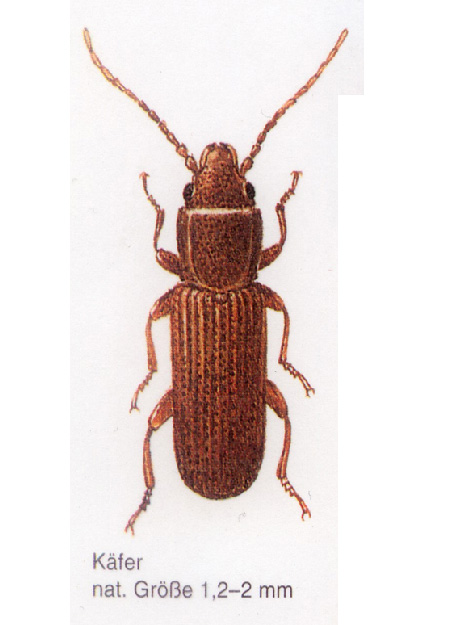Flat grain beetle
Cryptolestes ferrugineus
Appearance
The beetle, which is about 1.5 to 2.0 mm in size, is reddish brown in color and shows a slender, flat body shape, which makes it easier for it to move around in the cavities between the cereal grains. The head of the pest bears relatively long antennae, and the neck shield shows a fine longitudinal line on both sides.
The whitish to cream-colored larvae, up to 4 mm in size, bear two thorn-like appendages at their posterior end.

Biology
The reddish-brown striped flat beetle belongs to the flat beetle family (Cucujidae).
The beetles and larvae avoid light, which is why often only a fraction of the beetles are found on the surface of the stored grain, while the main mass is found inside.
The beetles fly at higher temperatures. Their females lay up to 350 eggs in small crevices or on grain kernels. The larvae go through four stages in their development. They then pupate in crevices and cracks of their store or food substrate. Their development is possible between 20 °C and 38 °C. Under optimal conditions (32 °C and 70-90 % relative humidity), the development of a generation takes four to five weeks, at 21 °C about two and a half months. Development is still possible even under very dry conditions and grain moisture below 12%.
The life span of the beetles can be up to a year even at a higher temperature, and they can starve for up to about 17 days.
The reddish-brown groin-headed platemarked beetle is insensitive to cold temperatures, and even -5.5 °C can be endured by the beetles for a few weeks. Therefore, overwintering in unheated storage rooms is quite possible in Central Europe. Above 42 °C, all stages die quickly.
Damage symptoms
The reddish-brown bar-headed platypus beetle does not produce a typical feeding pattern. A high proportion of broken grain or already eaten grains favors its mass reproduction, with the embryo being gnawed on preferentially. Due to the hidden way of life of the pests, the infestation in the grain store is very often noticed late.
High infestation density and enormous feeding activity of beetles and larvae and the associated metabolic processes result in the formation of heat nests (40 °C, hot spots) and an increase in moisture in the stored material. This makes it easier for fungi and bacteria to colonize. The stored goods become inedible and take on a manure-like odor. The high temperatures in the stored goods cause condensation to form on their surface and the stored grain may start to grow there.
Host plants
Host plants of the reddish-brown inguinal flatworms are broken cereals, cereal products of all kinds, nuts, spices, oilseeds and animal feed. Larval development is also possible in loose substrates such as flour. The beetle is mainly found in stored grain stocks (warehouses, silos, farms, food processing plants and households).
Propagation and transmission
Reddish-brown bar-headed flatworms are flight-capable beetles. They probably came to Austria through free trade in grain products. Further dispersal here then occurred by flying adult beetles. However, transmission would also be conceivable through cereal products contaminated with eggs or larvae.
Prevention and control
General hygiene measures
- periodic, thorough cleaning of storage facilities
- Pest monitoring
- temperature measurement, cooling, drying
- disposal of junk and plaster waste
- destruction of already infested supplies
- Mechanical deterrence of beetles by sealing windows and doors (insect screens), insulating ceilings, walls and pipes (preventing condensation), plastering crevices, cracks and porous walls.
- Thorough cleaning of harvesting and transport machinery and storage areas prior to crop storage.
- Void treatment with an approved insecticide or heat treatment.
- Cooling of the stored crop to 10-13 °C.
Proof
- Periodic temperature measurement: a rise in temperature in the stored goods provides information about the presence of storage pests.
- Sampling with a grain sampler
- Sieving of the samples with a continuous sieve
- Noise measurement: detection of larval feeding noises by inserting a sensitive microphone into the stored food.
Control
- Inert dusts (diatomaceous earth) and contact insecticides allow successful control of adult beetles and larvae when properly distributed in the stored material. However, eggs already laid in the supplies are not detected and lead to renewed infestation by the red-brown inguinal flat beetle at temperatures above 15 °C.
- Reliable killing is achieved with gaseous agents (hydrogen phosphide, see list of plant protection products approved in Austria) including inert gases (nitrogen, carbon dioxide) if the dosages, temperatures, exposure times specified for treatment are observed and if the stores to be treated are gas-tight.
- Thermal treatments (60 °C for three minutes) or cold treatments (below -10 °C) are possible, but only effective for smaller batches due to the energy required.
Tips for household use
- Store food only in tightly closing storage containers with rubber seals or screw caps.
- Dispose of all infested food directly in the waste garbage can outside the house
- Remove bugs sitting around with a vacuum cleaner
- Fly screens on (roof) windows, doors and skylights reduce the risk of infestation
- If you keep having to deal with reddish-brown bar head flat beetles, heirloom wasps can help. These are natural enemies of the beetles and are simply released in the kitchen(Lariophagus distinguendus see list of plant protection products approved in Austria).
Specialized information
In addition to the reddish-brown striped flat beetle, there are other closely related species with similar habits, such as C. pusillus, C. turcicus, C. capensis, and C. ugandae. In addition, species such as C. ater, C. duplicatus, and others that hibernate outdoors also occur in our area and were probably previously confused with striped head flat beetles, but are not stored-product pests.
Last updated: 06.09.2024
automatically translated